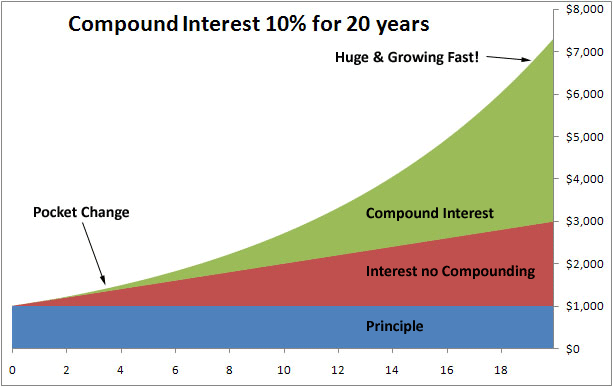Compound Interest versus Simple Interest
Post on: 16 Март, 2015 No Comment

I have had many people ask me what the difference is between simple and compound interest. Because of the questions, I decided that I will discuss the differences.
Simple Interest
Simple interest is a basic way you accrue the interest you earn on your money. If you have $100 in the bank and you earn 10% interest, after one year with simple interest you will have earned $10. The formula is:
Simple Interest = Principal x Rate x Time
Assume in the next year your bank account, now having $110 still earns 10% interest. At the end of the second year, you earned another $10 interest. You now have $120. As you can see, in the second year, you still earn interest on the original $100. When you think of simple interest, remember that your money grows slowly with simple interest and that you only earn interest on your original balance.
Compound Interest
Compound interest is interest you earn not only on your money, but on the interest as well. Using the same example from above, with $100 invested at 10%, at the end of the first year, you have earned $10 in interest. You may notice that is the same you earned with simple interest. While this is correct, difference between simple and compound interest has not yet been seen.
At the end of the second year, still earning 10% interest, you earned $11 in interest. Why the extra $1? Because in the second year, with compound interest, you earned interest on the interest you previously earned. Put another way, you earned interest on the $10 you earned last year. With simple interest, you are only earning interest on your principal amount.
Compound interest is a more involved way you accrue the interest. You earn interest not only on your money, but on the interest as well. I know, it sounds a little confusing but it’s really not. The formula for compound interest is more involved and your best bet is to use a calculator. You can use my free compound interest calculator to enter your own assumptions. Here is the formula for those wanting to try it out:
Using the same example from above, assume you have $100 invested at 10%. At the end of the first year, you have earned $10 in interest. You may notice that is the same amount of interest you earned with simple interest. While this is correct, difference between simple and compound interest has not yet been seen.
When we move to the second year, you are still earning 10% interest. The difference is that you earned $11 in interest. Why the extra $1? Because in the second year, with compound interest, you earned interest on the interest you previously earned. Put another way, you earned interest on the $10 you earned last year. With simple interest, you are only earning interest on your principal amount.
Savings vs. Loans
For the most part, nowadays all savings vehicles use compound interest while most loans use simple interest. When looking at savings products, be sure to pay attention to how frequently the interest compounds. You’ll see things like daily, monthly and annually. The more frequent the compounding, the quicker your money will grow. Ideally you would want compound interest to compound daily. (If you’re bored, you can test out how much more you would earn if you could get a compound interest frequency of hourly or every second. Surprisingly, there isn’t much of a difference!)
Why Compound Interest is The Path to Wealth
You may be thinking that the extra $1 you earn in the second year isn’t a big deal. But it is. Take a look at the chart below. It assumes that you invested $100 at 10% (same as above). The first column is the amount of money you have at a given year if you earned simple interest. The second column is the amount of money you have in a given year if you earned compound interest.
As you can see, at the start, there doesn’t appear to be much of a difference. But look what happens after 10 years and beyond. That is huge. Below is the same information as a graph (clicking on it will make it bigger).
If you had to pick which line was your bank account balance, which one would you choose? I’m hoping you picked compound interest!
Final Thoughts
You might be reading this and still think compound interest isn’t so great since you have to wait 30 years to see a difference. Understand that I’m only showing you what $100 grows to with compound interest. If you have $20,000 invested for just 10 years at 5% interest, you end up with an extra $12,000. (To play around some more with compound interest, use this great savings growth calculator .)
I know you want to strike it rich today. but unfortunately, the odds are against that. Instead of dreaming and wishing for it, go out and make it happen. The journey will be more than worth it. Be sure to read my post on how to become a stock market millionaire which takes into account compound interest and time.
If you are just starting out, I encourage you to start using a free excel budget template or open up a free Power Wallet account to start tracking your progress.














